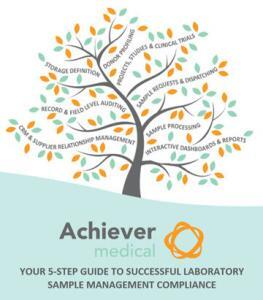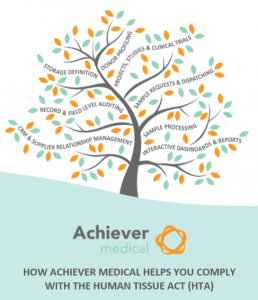Taking a fresh look at laboratory compliance and how it can benefit you and positively impact your results
Laboratories, Biobanks and other biological sample repositories must comply with several legal and industry controls. You may see these as a bit of a burden. However, if you carefully consider the responsibilities and benefits of lab compliance then the advantages can far outweigh the effort. Laboratory compliance involves you having the required policies and procedures to ensure adherence to the law. Software systems, such as laboratory management information management software (LIMS) and sample tracking software, can help by providing visibility and traceability of data.
However, recognising that these initiatives are designed to drive quality and improve lab operations, you can change your approach to compliance. Therefore, focusing on gaining optimum benefits through compliance rather than simply going through a tick in the box exercise.
Consider your customers when identifying the benefits of laboratory compliance

Your business goals and objectives will change over time, so it is important to regularly review and update your procedures. Every lab or biological sample repository has “customers” – those groups and institutes that require your services or outputs. These outputs can include test results, processed specimens, samples for research or documented proof of legal compliance. An effective lab evolves in response to changes in its customers’ needs. Further your “customers” may require you to comply with certain guidelines or have a particular accreditation.
To facilitate this process, you should consider a feedback loop between your customers and your lab management. This approach will allow you to identify changing needs and implement responses. As you apply the changes, you should monitor the effects to ensure that the expected benefits are actually being realised.
In addition, you should consider any changes in line with accreditation or compliance guidelines. These can help steer you towards best-practice approaches and instil quality considerations from the beginning. Again, this is where lab software such as LIMS systems can help.
Understanding the different types of lab compliance
The responsibilities and benefits of laboratory compliance involve legal regulation such as the dreaded acronyms HTA, MHRA and GDPR. They also include formal industry best-practice accreditations such as ISO 17025, ISO 15189 and ISO 20387. In addition, these may also include guidelines such as the Caldicott principles and ISBER best-practices.
What do you have to comply with?
Depending on the types of samples or data that you handle in the UK you will need to comply with one or more of the following laws. In other countries there are equivalent regulations. The legislation you must comply with depends on your type of collection. Human tissue has very specific legislative controls and donor-identifiable tissue even more so. The type of processing of the samples is also relevant, so if it is related to drug or medical device development then MHRA is applicable.
- Human Tissue Act (HTA) – This is law in the UK although it is enacted via slightly different legislation in Scotland. This controls the tracking and auditing of all human-identifiable cellular tissues. In addition to covering the provision of and the withdrawal of informed consent. Each licence has a Designated Individual named on the licence who is liable by law for the institute’s compliance
- Medicines and Healthcare products Regulatory Agency (MHRA) – This is law in the UK and is relevant to labs and institutes involved in the production of medicines and medical devices. It is necessarily very stringent and ensures that medicines and medical devices work and are acceptably safe
- General Data Protection Regulation (GDPR) – This is law in the UK and Europe and covers the appropriate management and safe storage of personal data. It is relevant to all institutes that hold data about people
Industry accreditation and guidelines
In addition to the legal regulations there are several accreditations that you may decide are valuable to achieve. You should choose the most relevant standards based on your type of lab or collection. Diagnostic, calibration and research labs each have their own accreditations. Finally, there are the “best practice” guidelines that you may decide to adopt.
- ISO 17025 – This European standard is recognised not just in the UK and Europe but is relevant to labs worldwide. It is a general standard for competence of testing and calibration labs
- ISO 15189 – This European standard is also in use widely in the UK for medical labs and is a standard for competence of medical diagnostic labs
- ISO 20387 – This European standard is also in use widely in the UK and is a standard for biological sample processing along the lines of HTA safeguarding impartiality and underpinning confidentiality protection. It is sometimes known as “ISO 9001 for labs”
- Caldicott Principles – The UK Government commissioned these guidelines that underpin the ethical usage storage and sharing of patient data in the UK
- ISBER best practices – The International Society for Biological and Environmental Repositories is a respected body that has produced a very thorough set of recommendations in relation to best practice in the operation of biological sample repositories
When considering the benefits of laboratory compliance

Naturally you must comply with the mandatory legislation. However, for any additional accreditation, you decide which are appropriate for you and which guidelines you want to adopt. This is all driven by what your customers want and will respect. Those accreditations confirm that you are managing your processing professionally and upholding values that your customers will respect. Even the legislative compliance, although mandatory, still supports your reputation and builds trust.
The benefits of your laboratory compliance fall into several categories:
Reputational benefits
Those logos you have on your website, publications and paperwork all contribute to your reputation. They show that you adhere to rigorous standards. They often come with affiliations on specialist websites and social media to help you to get noticed. All this helps to raise awareness of your services and that helps the inflow of new customers. New and existing customers gain confidence. As a result. this brings in business, which helps with the finances, whether that is cost recovery for a not-for-profit facility or revenue for a self-funded business.
Supporting funding bids
Funding bodies always strive to ensure that you use their funding to maximum benefit. One very important factor in those assessments is the ability to measure outcomes. That measurement relies on robust auditing of procedures. If those procedures are standardised that makes it easier to measure and compare. Accreditation and standards marques all increase the confidence of funders that your services will be professional and efficient.
Internal process efficiency
Standardising your processes according to best-practice allows you to benefit from the years of experience and process development already done by others. In addition, these processes are designed to be easily audited to prove compliance. Even where you need to develop your own processes the ISO standards indicate clearly what you need to measure and why. This allows you to consider this when developing your own processes.
Efficient processes lead to fewer mistakes, require less time to carry out and result in better data quality. Laboratory information management systems (LIMS) have been designed to help manage your lab operations and improve the quality of your data.
Improved data quality
Standardised processes result in more consistent results and this is because the processes are more easily repeatable. Your documentation should dictate how you take measurements, how you record them and which units of measure you use. They also help to ensure that you record all required values so incomplete data should become less of an issue. Using a computer system that enforces mandatory fields and checks data types and predefined lists of allowed values also helps. However, having a process that all staff understand and follow is a necessary first step.
Confidence of study donors and collaborators
Again, accreditation and supported standards add confidence for other parties with whom your lab deals such as tissue donors who make generous commitments to support your aims. That might involve donating tissues or giving access to data and also giving up their time to complete paperwork such as informed consent and questionnaires. Donors should have confidence that you are using their biological samples and data and you are protecting them in line with the agreed aims of the project. Collaborators also need that confidence that the time and effort they invest in working with your lab is well spent and that you are matching (or exceeding) their standards – to the benefit of both.
Standardising processes
If staff are carrying out the same process in slightly different ways, then any discrepancies can cause serious issues. For example, if processed samples are not ready for the next processing step at the same time-point/location or processes stall because of missing paperwork or data updates. These little stall points typically require checks and discussion between staff. At best, this interrupts them and detracts from what they should be working on. At worst, the process stalls or continues without the required information or approval.
However, if everybody works the same way then you can anticipate confirmation points. In this way, you can optimise various processes to ensure the least interruption for all concerned.
Improved biological sample viability
Whenever a process stalls this can potentially cause issues with sample viability. Any delays to process can lead to biological samples being sat at room temperature for extended periods of time. This is not optimal for their viability and unplanned delays in processing/freezing can have an impact on their quality. Standardised processes, whether by legal requirement, adoption of accreditation or by following industry best-practice, result in clearer flows of lab work, fewer holdups and better quality samples.
Challenges with laboratory compliance and standardisation
There are clearly a lot of benefits, so why isn’t every lab standardised already? There are challenges.
Time to set up and audit

Very often lab staff are running at 100% utilisation just keeping up with day-to-day work.
Therefore, taking time out to set up and carry out audits of current processes is a real challenge. Add in absences due to illness and annual leave and it becomes doubly difficult. However, if you cannot break that cycle you will be running flat out indefinitely. You will just compound the issues that you have already highlighted.
You need to make time to do some auditing to identify the issues. Then you can go to management with evidence that you need to make changes. Audit data also helps with the inevitable external audits, whether they be HTA, MHRA or ISO assessments. If you already have evidence, it makes the auditing process much less stressful.
Finally, when you have optimised your processes you can look back and wonder “How did we manage with the status quo how it was?”. Software systems such as LIMS and sample tracking software have inbuilt auditing that track changes to your data. These can help remove many of the manual record keeping exercises that you have to carry out.
Inertia and fear of change
Resistance from staff is often a barrier, especially if they have been in post for a long time. The often heard “We’ve always done it like this” can seem to be justified sometimes. If the process has not changed for a number of years that obviously means it is standardised? Well, no. Standardisation is not the same as consistency. It is about having the same process as other teams and institutes and, importantly, between different staff in the same lab. Lab staff should not be working to processes that are just in their heads or individually documented. The documentation should be for all staff and should be available for interrogation by external parties. It can take you time to change your processes in the short-term, however, they should bring big benefits once bedded in and are familiar to all.
Costs of memberships
Accreditation and compliance come at a cost. Even if there is no group membership fee (very few are free), you still have the cost of your team’s time spent auditing and implementing changes. However, it is easier to justify the costs if you are clear on the additional value accreditation will deliver.
In summary
The responsibilities and benefits of lab compliance can be expensive in terms of time and money. However, these should be greatly outweighed by the benefits of having efficient, optimised processes that are clearly documented and periodically tested to evidence that compliance. Your business will be more professional as a result. Further, you can reinforce your professionalism through accreditation which leads to recognition by your funders, biological sample donors, collaborators and your peers.
Finally, consider how lab software such as laboratory information management (LIMS) and sample tracking systems, can help remove some of the manual activities you have to carry out. As a result you can reduce unnecessary administration overheads – as well as some of the stress.



